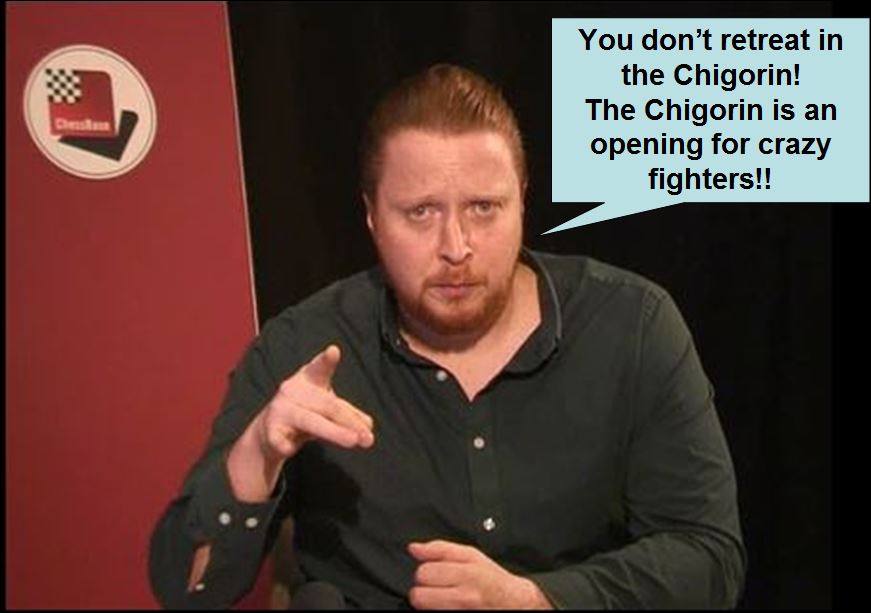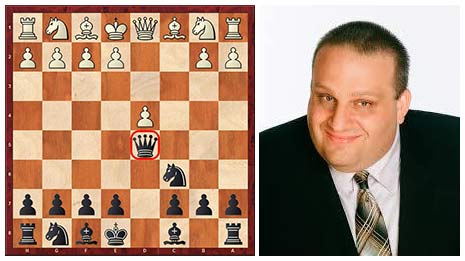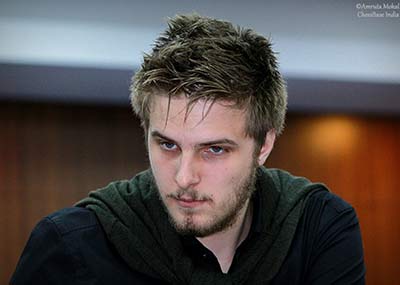No retreat
Williams is one of the most notorious GMs, and event commentators. He is not one of the top ten players in the world, but he has a gift like the best players on the planet. He can convey chess ideas, especially opening repertoires in a very funny, and pragmatic way. He doesn't give you stuff you don't remember, he outlines the most important ideas one must remember and know in order to play the opening successfully. This is what we want from the finest teacher, to make the burden of learning the material bearable, and most of all to be able to use those ideas as soon as possible.

Speaking of crazy fighters...

In the beginning of the DVD, Williams mentioned the one who has reinvigorated such old opening used over 100 years ago: Alexander Morozevich
One of the top Russian GMs, Morozevich played several interesting games in this variation over a decade ago.
Williams studied this opening for one month, and created this DVD which he divided in three parts, for our better understanding.
How does the Chigorin defense start? 1.d4 d5 2.c4 Nc6
The first part of the DVD is dedicated to positions which occur after White forces the Black queen out in the middle of the field with 3.cxd5 Qxd5

Williams says this kind of line brings to positions with big tactical fights, as we can witness in the next game played by GM Finegold one of the top 50 GMs in the USA.
Incidentally, Finegold just opened his own chess center in Atlanta, Georgia.
Richard Berube 0-1 Benjamin Finegold
As always Williams tries to teach openings, which make our chess spicy, and attacking, because chess can be romantic also in this computer age! It is only up to us to take this idea, and make it happen in reality, like the hypermodern movement created a wealth of ideas in chess in the first years of the last century.
This is the reason why we need to study chess openings, not because we hope to win a game in ten moves, but because chess openings will unlock our chess minds to a wealth of ideas which we didn't have before. So what is the deal with the Chigorin defense? Here Black is saying:
"I'm giving up a pawn center, but in exchange I gain a quick development of my pieces, which I'll use to attack!"

Often in chess in order to learn quick development, and bring out the pieces, we watch Morphy's games. But can such formative concept be taught in other ways? I believe so, and GM Williams also points it out. After the moves 1.d4 d5 2.c4 Nc6 3.cxd5 Qxd5 4.Nf3, can you guess what should Black play?
Learn about one of the greatest geniuses in the history of chess! Paul Morphy's career (1837-1884) lasted only a few years and yet he managed to defeat the best chess players of his time.
4...e5! A key move, which in Williams' words is based on letting go of a pawn center, for gaining a quick piece development — that quick piece development we witnessed in Morphy's games.
What else can an opening teach us? Would you ever guess an opening can teach you the mastery over some particular pieces? This is clearly the case with the Chigorin defense played by what is considered the father of Russian's chess Mikhail Chigorin.

He was famous for preferring knights over bishops. Today we consider owning the bishop pair a good advantage which can bring us to win the game, especially in the endgame. But as growing players, if we are not GMs, and 99.7% of all players are not, shouldn't we try to grow practicing openings which teach us how to use different piece combinations, and in this case the knight pair?
Here the movie spoiler: in the Chigorin defense Black gives up the light squares bishop for the Nf3, and generally the dark squares bishop for the Nc3.
By the way, in my Megabase 2017 (soon to become Megabase 2018, because I already acquired the update!) there are over 10000 games with the Chigorin.
The second part of the DVD is dedicated to the positions coming out from
1.d4 d5 2.c4 Nc6 3.Nf3
Also in this case there are beautiful romantic games to show, and to use as example of the mindset in which one should play.
Michael Edward Brigden 0-1 Anthony J Miles
The last part of the DVD is based on 1.d4 d5 2.c4 Nc6 3.Nc3, and other moves White could play.

GM Williams in the introductory video used "three parts" but the actual DVD, maybe for production reasons, has been divided in four parts.
The DVD comes with a database of 60 games for studying, as well as a "working database" of 22 games, composed of the games presented in the videos.
The DVD ends with eleven interactive videos, where Williams presents some positions, and ask viewers to find the right move, giving feedback when we don't get it.
After presenting the DVD, as reviewer, I must check if some of the data given by Williams are true. For example in the introductory video he says: "Morozevich went through a phase in which he was playing the Chigorin against top players with fantastic results..." Now, let's be clear, top players are difficult to beat, hence the statement "fantastic results" must be evaluated for truthfulness. In my megabase 2017 I have 35 games played by Morozevich with the Chigorin defense (also defined by ECO as D07. D08 is the Albin counter-gambit, and Morozevich also played that opening), from 1994 to 2015, but the main period in which he used it often was the years 1994-1995.
Out of 35 games Morozevich won 12, lost 12 and drew 11. Now I don't know if to lose as many games as one wins is "fantastic." From what I saw, against the top players: Kortchnoi, Ivanchuk, Anand, Timman, Shirov, Topalov, Kramnik etc. he drew or lost the game. But again, it would have probably happened with any other opening too.
However Williams in many videos mentions Morozevich's games and tell us where he thinks Morozevich went wrong, and how to avoid the problems Morozevich had. This shows that Williams truly did the homework, and he is giving us a new and improved version of the opening used by Morozevich and other players.
 Another player mentioned is Rapport Richard (there is also a Jovana Rapport who used the Chigorin often) who played this opening eight times with the result of one win, four losses, and three draws. Again not impressive as result, but how do we compare an opening used with Black against players rated 2700?? I never played a 2700, and I'm pretty sure I'd lose also against a 2400, so does it really make any difference if I use the Chigorin or the Slav against a 2400+? I'm sure it doesn't. The problem is that Williams says "Rapport used the Chigorin to crush top players, recently against Aronian..." and that's true, but that was the only win Rapport had out of 8 games.
Another player mentioned is Rapport Richard (there is also a Jovana Rapport who used the Chigorin often) who played this opening eight times with the result of one win, four losses, and three draws. Again not impressive as result, but how do we compare an opening used with Black against players rated 2700?? I never played a 2700, and I'm pretty sure I'd lose also against a 2400, so does it really make any difference if I use the Chigorin or the Slav against a 2400+? I'm sure it doesn't. The problem is that Williams says "Rapport used the Chigorin to crush top players, recently against Aronian..." and that's true, but that was the only win Rapport had out of 8 games.
Generally I tend to give more credit to those who actually play the opening, and suffer with it, since all openings are source of sufferings before mastering them, and even after!
Williams played this opening himself only one time as Black, against a player 300 points less than him, and drew.
But he must have been scared by this opening, because as White, in 2010 he made a three moves draw against another top UK GM, Nick Pert! (Pert is really dangerous, he plays always for a win!)
Many club players have their favourite pet opening variations which aren’t necessarily main lines. It’s important to know how to handle these variations as your opponent will likely know his systems well. In this DVD, GM Nicholas Pert provides a detailed Black repertoire against many of these Offbeat Opening choices.
Vassily Ivanchuk used the Chigorin to beat Ding Liren, who's now in the Candidates Tournament to select the challenger to the World Champion. But apart from this big name, I didn't see many others. What does this mean? I think it means the Chigorin could be the perfect weapon at club level. There are no top ten players in the world using it (or fighting against it) which means the majority of the chess amateurs are totally unaware of the ideas behind such opening, compared to the King's Indian which is used a lot at top level, and every level.
Final thoughts
Williams over and over tries to teach us gambit play. He tries to teach us the importance of development over material, like giving the opponent a one pawn advantage, and this is clearly the road to mastery. If we don't master these positions, and openings, which oblige us to think of the most sharp and fast moves to win, we will never reach master level. Does this mean we must play the Chigorin all our lives? No! But let's play it for six months to a year, and see if after such experience we have become better players. I will certainly add it to my repertoire, and play it in tournaments.
Williams is really good in passing the ideas behind the opening, and this is what I'm looking for in chess books, and often I don't find it. For example Williams explains the important squares one should occupy, or the diagonals one should control, and what is the plan in some pawn structures. Often toward the end of the video he reiterates the main points, which is definitely good!
One last thought, many of the lines chosen by Williams are tactically complicated, which means if one uses them in rapid play our opponents will likely blunder or use a huge amount of time for calculating the correct moves, this could be the advantage we need to win a game.
So, give this opening a try — it is definitely worth it!
Opening with the Chigorin shows your intention to play for a win right from the outset. After 2...Nc6 Black's pieces fly into the game putting pressure on White's position from a very early stage. This opening is ideal for the type of player who strives for an unconvential yet attacking game right from the start.
Links





















 Another player mentioned is Rapport Richard (there is also a Jovana Rapport who used the Chigorin often) who played this opening eight times with the result of one win, four losses, and three draws. Again not impressive as result, but how do we compare an opening used with Black against players rated 2700?? I never played a 2700, and I'm pretty sure I'd lose also against a 2400, so does it really make any difference if I use the Chigorin or the Slav against a 2400+? I'm sure it doesn't. The problem is that Williams says "Rapport used the Chigorin to crush top players, recently against Aronian..." and that's true, but that was the only win Rapport had out of 8 games.
Another player mentioned is Rapport Richard (there is also a Jovana Rapport who used the Chigorin often) who played this opening eight times with the result of one win, four losses, and three draws. Again not impressive as result, but how do we compare an opening used with Black against players rated 2700?? I never played a 2700, and I'm pretty sure I'd lose also against a 2400, so does it really make any difference if I use the Chigorin or the Slav against a 2400+? I'm sure it doesn't. The problem is that Williams says "Rapport used the Chigorin to crush top players, recently against Aronian..." and that's true, but that was the only win Rapport had out of 8 games.




